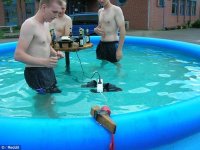- Location
- Illinois
- Occupation
- retired electrician
The 5 mA does not apply to lakes and rivers. 555.3 in the 2017 code required 30 mA protection for feeders and branch circuits for those types of applications. In the 2020 those requirements were moved to 555.35 and requires 30 mA protection for shore power receptacles and 100 mA protection for feeders and branch circuits. They reworded it a bit, but the 2023 rule is pretty much the same as the 2020.I am confused.
Doesn't the code cover this with GFI protected outlets installed near water environments? As I recall the GF current that flows in the water is limited to 5 MA before it trips the circuit. Low enough for people protection. Or are we seeing people dying in spite of this protection?
This is partly based on the American Boat & Yacht Council's (ABYC) voluntary boat construction standards that requires 30 mA protection in the boat. There is just too much leakage current to make 5 mA GFCIs work.
Note the the 30 mA devices are GFPE and they have no time to trip requirements like GFCIs do.



